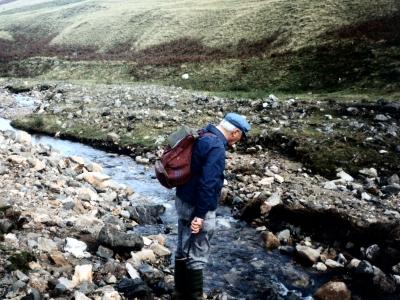
Jim on a field trip to the Caldbeck Fells in 1998.
"Pyromorphite,
my favourite mineral",
by Jim Goulding
Former Southampton Mineral & Fossil Society
Chairman Jim Goulding sadly passed away in January 2010
and is greatly missed by the Society and all who knew
him. In this, his original web site page from 2001 Jim
gives us a brief look into his favourite mineral,
pyromorphite of which he had very extensive collection
acquired over many years of mineral collecting. His
enthusiasm for his hobby was immense as was his
willingness to pass on his knowledge and enthusiasm.
Jim was the field trip organiser for the Society for
some time and never missed an opportunity to arrange
collecting trips to classic pyromorphite sites.
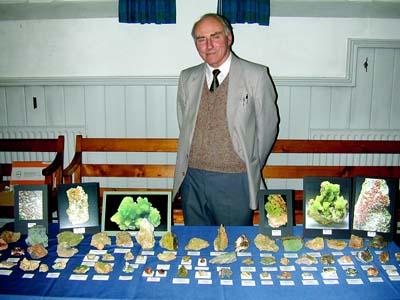
Jim with some of his pyromorphite collection after presenting a talk on the mineral at a Society meeting.
Chemically pyromorphite is lead phosphate chloride,
Pb5(PO4)3Cl. The name
derives from the Greek pyr , fire and
morph , form which alludes to the crystalline
shape that the melted mineral takes on cooling. The
colour varies from green, yellow, orange, brown, grey,
white or colourless. The streak is white and the luster
is subadamantine to resinous. Hardness (Mohs) is 3.5 to
4 and the specific gravity is 7.04. Pyromorphite
belongs to the hexagonal crystal system and the habit
is usually short hexagonal prisms, often barrel-shaped,
cavernous, equant, tabular, pyramidal or granular.
Pyromorphite forms a solid solution series with
mimetite,
Pb5(AsO4)3Cl, as
arsenic replaces phosphorus in the structure. Mimetite
also forms a series with the mineral vanadinite,
Pb5(VO4)3Cl.
Pyromorphite is quite a widespread mineral in the
British Isles and some beautiful specimens can be found
at many sites. Below are some images of some of my
pyromorphite specimens from around England.

Specimen from Driggeth mine, Caldbeck Fells, Cumbria.
This fine, pale green specimen from the Driggeth mine
dumps was collected on the SMFS field trip to Cumbria
in September 1998. The extensive old mine dumps of the
Caldbeck Fells are classic sites and can still turn up
some interesting specimens. Most of these are small and
take a lot of searching for but can have interesting
forms.
Collecting on the Caldbeck Fells has now been banned as the area has been the target for destructive commercial collecting and much evidence of this can be found. To collect there now requires a permit from the LDNPA.
Collecting on the Caldbeck Fells has now been banned as the area has been the target for destructive commercial collecting and much evidence of this can be found. To collect there now requires a permit from the LDNPA.
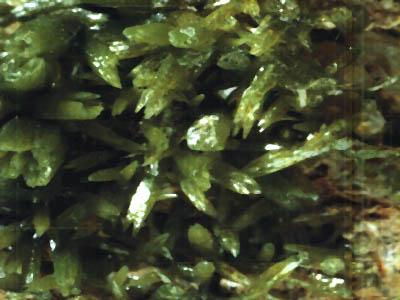
Specimen from Wheal Alfred, Phillack, near Hayle, Cornwall.
Some of the best pyromorphite in Cornwall was found at
Wheal Alfred, Phillack, near Hayle. This was an old tin
mine that also produced some copper in later years it
finally closed in 1862. Pyromorphite from this location
is now rare but can still be found on sale. This
specimen was purchased from the mineral dealer Sam
Weller in 1994.
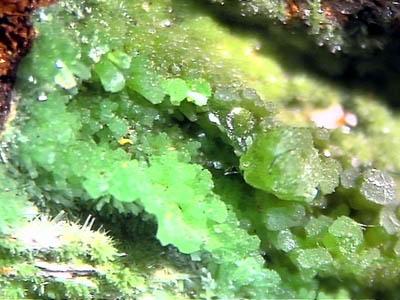
Specimen from Flory Island, Watergate Bay, Cornwall.
Flory Island, is situated at the southern end of
Watergate Bay, Cornwall in the oldest rocks, with the
exception of the Lizard, between Padstow and Falmouth,
being about 400 million years old, The iron stained
killas (Cornish mining term for metamorphic rock of
sedimentary origin) in the area is very loose and
crumbly with small cavities lined with beautiful green
pyromorphite.
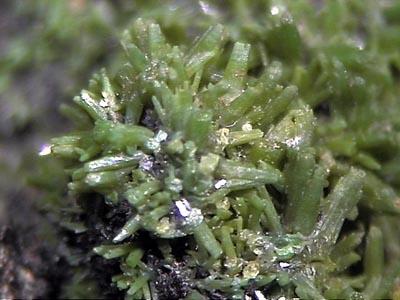
Specimen from Burgham Mine, Shelve, Shropshire.
Small olive-green pyromorphite crystals liberally
covering a black, botryoidal psilomelane matrix from
the old mine at Burgham, near Shelve, Shropshire.
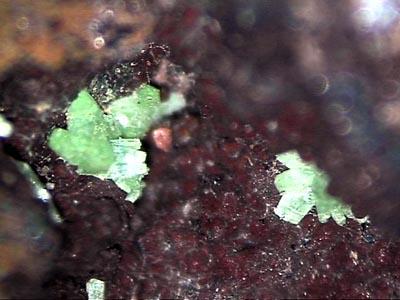
Small crystal sprays from Whatley Quarry, Frome, Somerset..
These very small (2 mm - 3 mm) pale green hexagonal
crystals are on a friable matrix of iron and manganese
oxides. They were found in a single loose boulder at
Whatley quarry in 1990 and nothing similar has since
been reported.
(Editors note:) Analysis by R. Turner of supposed specimens of 'pyromorphite' from nearby Torr Works quarry (Merehead) were actually found to be greenish coloured mimetite. Given that pyromorphite has not been found to occur at Torr Works then it is possible that this specimen is also mimetite. This would need confirmation.
Reference: [Turner, R.W., (2006) A Mechanism for the formation of the Mineralised Mn Deposits at Merehead Quarry, Cranmore, Somerset, England. Min. Mag. vol. 70, no. 6, pp 629 - 653]
(Editors note:) Analysis by R. Turner of supposed specimens of 'pyromorphite' from nearby Torr Works quarry (Merehead) were actually found to be greenish coloured mimetite. Given that pyromorphite has not been found to occur at Torr Works then it is possible that this specimen is also mimetite. This would need confirmation.
Reference: [Turner, R.W., (2006) A Mechanism for the formation of the Mineralised Mn Deposits at Merehead Quarry, Cranmore, Somerset, England. Min. Mag. vol. 70, no. 6, pp 629 - 653]

Specimen from White Rake, Tideswell, Derbyshire.
This specimen was collected from the old dumps at White
Rake, Derbyshire. The dumps were being reworked for
fluorite and them back filled with landfill waste. It
appears that these were recent dump formed crystals in
one small area which has now been infilled.